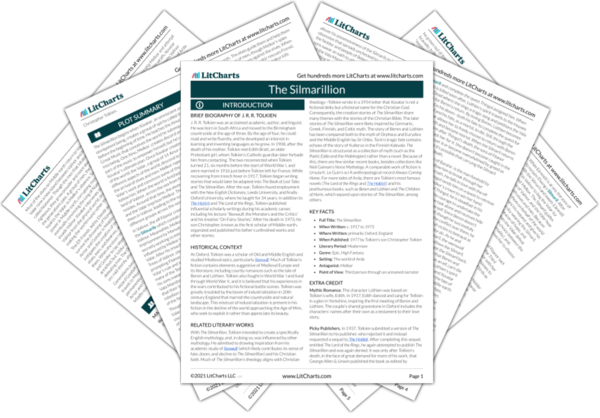Welcome to the LitCharts study guide on J.R.R. Tolkien's The Silmarillion. Created by the original team behind SparkNotes, LitCharts are the world's best literature guides.
The Silmarillion: Introduction
The Silmarillion: Plot Summary
The Silmarillion: Detailed Summary & Analysis
The Silmarillion: Themes
The Silmarillion: Quotes
The Silmarillion: Characters
The Silmarillion: Terms
The Silmarillion: Symbols
The Silmarillion: Theme Wheel
Brief Biography of J.R.R. Tolkien

Historical Context of The Silmarillion
Other Books Related to The Silmarillion
- Full Title: The Silmarillion
- When Written: c. 1917 to 1973
- Where Written: primarily Oxford, England
- When Published: 1977 by Tolkien’s son Christopher Tolkien
- Literary Period: Modernism
- Genre: Epic, High Fantasy
- Setting: The world of Arda
- Antagonist: Melkor
- Point of View: Third person through an unnamed narrator
Extra Credit for The Silmarillion
Mythic Romance. The character Lúthien was based on Tolkien’s wife, Edith. In 1917, Edith danced and sang for Tolkien in a glen in Yorkshire, inspiring the first meeting of Beren and Lúthien. The couple’s shared gravestone in Oxford includes the characters’ names after their own as a testament to their love story.
Picky Publishers. In 1937, Tolkien submitted a version of The Silmarillion to his publisher, who rejected it and instead requested a sequel to The Hobbit. After completing this sequel, entitled The Lord of the Rings, he again attempted to publish The Silmarillion and was again denied. It was only after Tolkien’s death, in the face of great demand for more of his work, that George Allen & Unwin published the book as edited by Christopher Tolkien.







